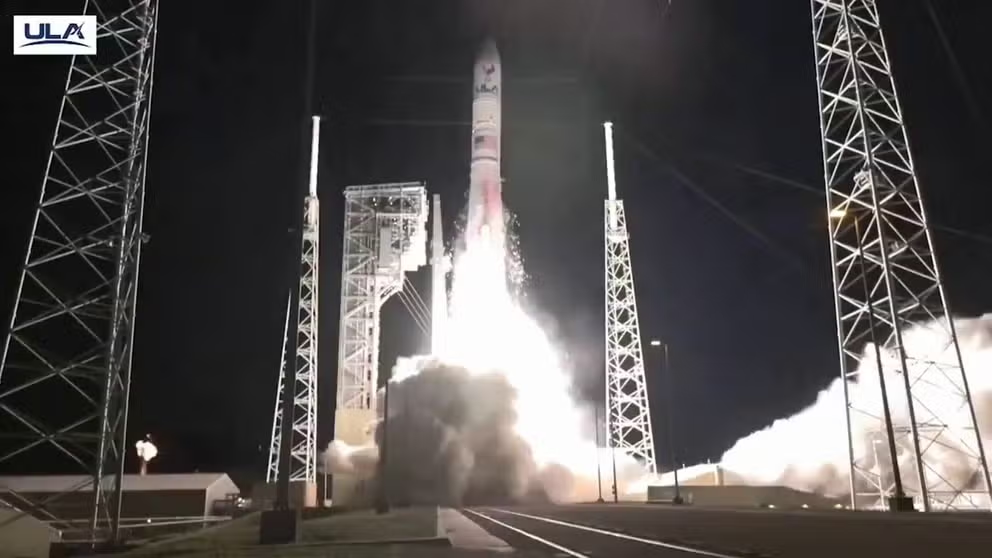ULA's second Vulcan rocket launch won't be with Sierra Space's spaceplane
Sierra Space gave up its spot on ULA's manifest to make way for the rocket to complete its certification missions and fly national security payloads. ULA is targeting September for the second launch of the new Vulcan rocket.
Inaugural launch of ULA's Vulcan rocket
ULA's Vulcan rocket launches for the first time carrying the Peregrine Moon lander to space. The liftoff happened from Cape Canaveral, Florida on Jan. 8. (video: ULA)
CAPE CANAVERAL, Fla. – United Launch Alliance's second Vulcan rocket launch will send a collection of technology demonstrations into orbit instead of Sierra Space's Dream Chaser spaceplane after company officials decided to "step aside" to make way for other launches that will help certify the rocket for national security missions.
On Wednesday, ULA CEO Tory Bruno told reporters Sierra Space's reusable 30-foot spaceplane wouldn't be ready for its demonstration flight by mid-year.
"We have been informed by Sierra Space that they feel they have significant risk towards making the flight date," Bruno said. "They have told us that they will step aside in order to support our critical national security space missions that come afterward."

Dream Chaser Tenacity and its Shooting Star cargo companion are shown stacked inside a thermal vacuum test chamber at NASA’s Neil Armstrong Test Facility on April 26, 2024. (Photo Credit: Joshua Teplitz/ Sierra Space)
(Sierra Space)
Sierra Space was awarded a contract under NASA's commercial resupply services program to fly supplies to the International Space Station using Dream Chaser. The first of the Colorado-based company's spaceplane fleet arrived at Kennedy Space Center in Florida last month after undergoing testing in a thermal vacuum chamber.
A company spokesperson told FOX Weather that Dream Chaser will fly by year's end.
"We continue to make excellent progress on Dream Chaser, and the spaceplane is on track to fly by the end of 2024. As a defense-tech prime, we understand how important ULA’s Cert-2 mission is to the criticality of national security and our launch partner’s schedule. We are working closely with ULA to identify the next available launch date," a Sierra Space spokesperson said.
Dream Chaser was designed to carry up to 3,500 pounds of supplies to the space station, and its Shooting Star cargo module can carry back and dispose of up to 8,500 pounds of trash.
Dream Chaser will dock at the space station during the demonstration mission and spend about 45 days in orbit before returning to Earth. The reusable spaceplane will land on the old Space Shuttle runway at Kennedy Space Center.
ULA targets September for Vulcan's second flight
Vulcan's certification-2 launch will mark the rocket's second flight. The first certification flight happened in January when Vulcan launched Astrobotic's Peregrine Moon lander. While the lander did not reach the lunar surface, the rocket's maiden launch was a success.
The Vulcan rocket needs to complete more certification flights before the U.S. Department of Defense certifies the vehicle to fly national security missions.
PEREGRINE MOON LANDER BURNS UP IN EARTH’S ATMOSPHERE ENDING ASTROBOTIC’S FIRST MISSION
"We have to fly our second and final certification mission before we can begin flying Vulcan for national security missions. There are two that need to be flown before the end of the year," Bruno said.
'MOST METAL OF ROCKETS' DELTA IV HEAVY SOARS FOR FINAL TIME, LAUNCHING TOP SECRET MISSION
In the meantime, Bruno said ULA is targeting September for the second certification mission of the Vulcan rocket from Cape Canaveral, Florida.
With Dream Chaser no longer the rocket's payload, the company will fly a mass simulator and several technology and science demonstration payloads.

A United Launch Alliance (ULA) Vulcan VC2S rocket launched the first certification mission from Space Launch Complex-41 at Cape Canaveral Space Force Station, Florida on Jan. 8, 2024 at 2:18 a.m. ET. Photo credit: United Launch Alliance
(ULA)
With the final Delta IV Heavy rocket launch complete in April, ULA is making room for more Vulcan rocket hardware and preparing its facilities at Cape Canaveral to support a faster-paced launch cadence with the new rocket.
Bruno said 23 Vulcan rockets are currently being built at ULA's factory.
There are just 16 of ULA's Atlas V rockets left, including six reserved for flying Boeing's Starliner spacecraft with astronauts to the International Space Station.
ULA launched the first Starliner with astronauts on June 5. NASA Astronauts Butch Wilmore and Suni Williams remain on the ISS while Boeing and NASA teams troubleshoot issues with Starliner before bringing them home.
Bruno said ULA is targeting eight launches this year and 20 launches in 2025.
